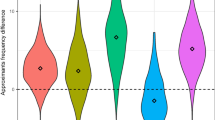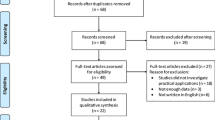Abstract
English lexical stress is acoustically related to combination of duration, intensity, fundamental frequency (F0) and vowel quality. Errors in any or all of these correlates could interfere with production of the stress contrast, but it is unknown which correlates are most difficult for L1 Bengali speakers to acquire. This study compares the use of these correlates in the production of English lexical stress contrasts by 10 L1 English and 20 L1 Bengali speakers. The results showed that L1 Bengali speakers produced significantly less native like stress patterns, although they used all four acoustic correlates to distinguish stressed from unstressed syllables. L1 English speakers reduced vowel duration significantly more in the unstressed vowels compared to L1 Bengali speakers and degree of intensity and F0 increase in stressed vowels by L1 English speakers was higher than that by L1 Bengali speakers. There were also significant differences in formant patterns across speaker groups, such that L1 Bengali speakers produced English like vowel reduction in certain unstressed syllables, but in other cases, L1 Bengali speakers had tendency to either not reduce or incorrectly reduce vowels in unstressed syllables. The results suggest that L1 Bengali speakers’ production of English lexical stress contrast is influenced by L1 language experience and L1 phonology.



Similar content being viewed by others
References
Amir, N., & Amir, O. (2007). Novel measures for vowel reduction. In Proceedings of Proceedings of International Congress of Phonetic Sciences (pp. 849–852). Saarbrucken.
Archibald, J. (1992). Transfer of L1 parameter settings: Some empirical evidence from polish metrics. Canadian Journal of Linguistics, 37, 301–339.
Archibald, J. (1993). Language learnability and L2 phonology: the acquisition of metrical parameters. Dordrecht: Kluwer Academic.
Archibald, J. (1995). Phonological acquisition and phonological theory. Hillsdale: Lawrence Erlbaum Associates.
Beckman, M. E. (1986). Stress and non-stress accent. Foris: Dordrech.
Blomgren, M., Robb, M., & Chen, Y. (1998). A note on vowel centralization in stuttering and no stuttering individuals. Journal of Speech, Language, and Hearing Research, 41(5), 1042–1051.
Boersma, P., & Weenink, D. (2001). Praat, a system for doing phonetics by computer. Glott International, 1, 341–345.
Chakraborty, R. (2006). Production of lexical stress in non-native speakers of English: Linguistic transfer and kinematic correlates of prosody. Doctoral Dissertation, Purdue University.
Chatterji, S. K. (1921). Bengali phonetics. Bulletin of the School of Oriental and African Studies, 2(01), 1–25.
Chaudhary, S. (2009). Foreigners and foreign languages in India: A sociolinguistic history. Cambridge, India.
Chrabaszcz, A., Winn, M., Lin, C. Y., & Idsardi, W. J. (2014). Acoustic cues to perception of word stress by English, Mandarin, and Russian speakers. Journal of Speech, Language, and Hearing Research, 57(4), 1468–1479.
Desai, S. B., Dubey, A., Joshi, B. L., Sen, M., Shariff, A., & Vanneman, R. (2010). Human development in India. Oxford: Oxford University Press.
Fear, B. D., Cutler, A., & Butterfield, S. (1995). The strong/weak syllable distinction in English. The Journal of the Acoustical Society of America, 97(3), 1893–1904.
Ferguson, C. A., & Chowdhury, M. (1960). The phonemes of Bengali. Language, 36, 22–59.
Flege, J. E., & Bohn, O. S. (1989). An instrumental study of vowel reduction and stress placement in Spanish-accented English. Studies in Second Language Acquisition, 11(01), 35–62.
Fokes, J., & Bond, Z. S. (1989). The vowels of stressed and unstressed syllables in nonnative English. Language Learning, 39(3), 341–373.
Fokes, J. E., Bond, Z. S., & Steinberg, M. (1984). Patterns of word stress by native and non-native speakers. In Proceedings of International Congress of Phonetic Sciences (pp. 682–686). Dordrecht.
Fry, D. B. (1955). Duration and intensity as physical correlates of linguistic stress. The Journal of the Acoustical Society of America, 27(4), 765–768.
Fry, D. B. (1958). Experiments in the perception of stress. Language and Speech, 1(2), 126–152.
Fuchs, R. (2016).The Acoustic Correlates of Stress and Accent in English Content and Function Words. In Proceedings of Speech Prosody 8, Boston, USA, pp. 290–294.
Fuchs, R., & Maxwell, O. (2015). The placement and acoustic realisation of primary and secondary stress in Indian English. Proceedings of international congress of phonetic sciences (pp. 380–383). Scotland: Glasgow.
Fujisaki, H., Hirose, K., & Sugito, M. (1986). Comparison of acoustic features of word accent in English and Japanese. The Journal of the Acoustical Society of Japan (E), 7(1), 57–63.
Gay, T. (1978). Physiological and acoustic correlates of perceived stress. Language and Speech, 21(4), 347–353.
Guion, S. G. (2005). Knowledge of English word stress patterns in early and late Korean-English bilinguals. Studies in Second Language Acquisition, 27(4), 503–533.
Guion, S. G., Clark, J. J., Harada, T., & Wayland, R. P. (2003). Factors affecting stress placement for English non words include syllabic structure, lexical class, and stress patterns of phonologically similar words. Language and Speech, 46(4), 403–426.
Hammond, R. H. (1986). Error analysis and the natural approach to teaching foreign languages. Lenguas Modernas, 13, 129–139.
Hayes, B., & Lahiri, A. (1991). Bengali intonational phonology. Natural Language and Linguistic Theory, 9(1), 47–96.
Kawasaki, H., & Shattuck-Hufnagel, S. (1988). Acoustic correlates of stress in four demarcative-stress languages. The Journal of the Acoustical Society of America, 84(S1), S98–S98.
Keyworth,P. R. (2014). The acoustic correlates of stress-shifting suffices in native and nonnative English. Master’s Dissertation, St. Cloud State University.
Khan, S. U. D. (2008). Intonational phonology and focus prosody of Bengali. Doctoral Dissertation, UCLA.
Kingdon, R. (1958). The groundwork of English stress. Longmans: Green.
Kochanski, G., Grabe, E., Coleman, J., & Rosner, B. (2005). Loudness predicts prominence: Fundamental frequency lends little. The Journal of the Acoustical Society of America, 118(2), 1038–1054.
Kondo, M. (2009). Is acquisition of L2 phonemes difficult? Production of English stress by Japanese speakers. In Proceedings of the 10th Generative Approaches to Second Language Acquisition Conference. Urbana-Champaign, pp. 105–112.
Koo, H. S. (1997). A study using acoustic measurements and perceptual judgment to identify prosodic characteristics of English as spoken by Koreans. Speech Sciences, 2, 95–108.
Lee, B., Guion, S. G., & Harada, T. (2006). Acoustic analysis of the production of unstressed English vowels by early and late Korean and Japanese bilinguals. Studies in Second Language Acquisition, 28(03), 487–513.
Lewis, M. P., Simons, G. F., & Fennig, C. D. (2009). Ethnologue: Languages of the world. TX: SIL international, Dallas.
Lindblom, B. (1963). Spectrographic study of vowel reduction. The Journal of the Acoustical society of America, 35(11), 1773–1781.
Major, R. C. (2001). Foreign accent: the ontogeny and phylogeny of second language phonology. Mahwah: Erlbaum.
Maxwell, O. (2014). The Intonational Phonology of Indian English. An Autosegmental-Metrical Analysis Based on Bengali and Kannada English. Doctoral Dissertation, University of Melbourne.
Maxwell, O., & Fletcher, J. (2009). Acoustic and durational properties of Indian English vowels. World Englishes, 28(1), 52–69.
Meng, H., Tseng, C. Y., Kondo, M., Harrison, A. M., & Visceglia, T. (2009). Studying L2 suprasegmental features in Asian Englishes: a position paper. In Proceedings of International Speech Communication Association. Brighton, pp. 1715–1718.
Michaux, M. C., Brognaux, S., & Christodoulides, G. (2014). The production and perception of L1 and L2 Dutch stress. Proceedings of Speech Prosody 7 (pp. 462–466). Ireland: Dublin.
Pickering, L., & Wiltshire, C. (2000). The prosody of Indian-EnglishTA’s teaching discourse. World Englishes, 19, 173–183.
Plag, I., Kunter, G., & Schramm, M. (2011). Acoustic correlates of primary and secondary stress in North American English. Journal of Phonetics, 39(3), 362–374.
Saha, S. N. and Das Mandal, S. K. (2014). Phonetic and phonological interference of English pronunciation by native Bengali (L1-Bengali, L2-English) speakers. In Proceedings of the Oriental COCOSDA International Conference. Phuket, pp. 1–6.
Sailaja, P. (2012). Indian English: Features and sociolinguistic aspects. Language and Linguistics Compass, 6(6), 359–370.
Sirsa, H., & Redford, M. A. (2013). The effects of native language on Indian English sounds and timing patterns. Journal of Phonetics, 41(6), 393–406.
Sluijter, A. M., Shattuck-Hufnagel, S., Stevens, K. N., and Van Heuven, V. J. J. P. (1995). Supralaryngeal resonance and glottal pulse shape as correlates of prosodic stress and accent in American English. In Proceedings of International Congress of Phonetic Sciences. Stockholm, pp. 630–633.
Sluijter, A. M., & van Heuven, V. J. (1996). Spectral balance as an acoustic correlate of linguistic stress. The Journal of the Acoustical Society of America, 100(4), 2471–2485.
Teng, E. (2001). The use of stress and vowel reduction by Chinese learners of English. Doctoral Dissertation, University of Texas.
Ueyama, M. (2000). Prosodic transfer: An acoustic study of L2 English versus L2 Japanese. Doctoral Dissertation, UCLA.
van Heuven, V. J. (2014). Acoustic correlates and perceptual cues of word and sentence stress: Mainly English and Dutch. In Proceedings of International Symposium on Tonal Aspects of Languages, Nijmegen, pp. 16–20.
Vijayakrishnan, K. G. (1978). Stress in Tamilian English: A study within the framework of generative phonology. Unpublished M. Litt. thesis, Central Institute of English and Foreign Languages.
Visceglia, T., Tseng, C. Y., Kondo, M., Meng, H., & Sagisaka, Y. (2009). Phonetic aspects of content design in AESOP (Asian English Speech cOrpus Project). In Proceedings of Oriental COCOSDA International Conference on Speech Database and Assessments. Beijing, China, pp. 60–65.
Wang, Q. (2008). Perception of English stress by Mandarin Chinese learners of English: An acoustic study. Doctoral Dissertation, University of Victoria.
Weinreich, U. (1953). Languages in contact. New York: Linguistic circle of New York.
Wiltshire, C., & Moon, R. (2003). Phonetic stress in Indian English vs American English. World Englishes, 22(3), 291–303.
Yeni-Komshian, G. H., Flege, J. E., & Liu, S. (2000). Pronunciation proficiency in the first and second languages of Korean-English bilinguals. Bilingualism, 3, 131–149.
Yu, V. Y., & Andruski, J. E. (2010). A cross-language study of perception of lexical stress in English. Journal of Psycholinguistic Research, 39(4), 323–344.
Zhang, Y., Nissen, S. L., & Francis, A. L. (2008). Acoustic characteristics of English lexical stress produced by native Mandarin speakers. The Journal of the Acoustical Society of America, 123(6), 4498–4513.
Zuraiq, W., & Sereno, J. A. (2007). English lexical stress cues in native English and non-native Arabic speakers. Ratio, 1, 2.
Acknowledgments
The read speech data of L1 American English speakers was given by Prof. Alexander L. Francis, Program in Linguistics and Department of Speech, Language and Hearing Sciences, Purdue University, West Lafayette, Indiana 47907. We thank him for his kind support, which helped us to do this study.
Author information
Authors and Affiliations
Corresponding author
Appendices
Appendix A
1.1 Detailed information of L1 English speakers
Table 5 represents the detailed personal information of 10 (5 male, 5 female) L1 American English speakers, where seven were from the central Midwest and remaining three were from California, New York, and Louisiana respectively.
Appendix B
2.1 Detailed information of L1 Bengali speakers
Table 6 represents the detailed personal information of 20 (8 male, 12 female) L1 speakers of Standard Colloquial Bengali, who have participated in the present study.
Appendix C
3.1 Aesop’s specified recording setup
The speech of L1 and L2 (L1 Bengali) English speakers was recorded by using AESOP’s recording tool kit with AESOP’s specified recording platform. The detailed description of AESOP’s specified recording setup is given below.
-
Recording environment
Recording can be conducted in quiet room, such as a seminar room, lab, or a class room.
-
Sound card
Sennheiser PC155 comes equipped with a built-in sound card. No driver installation is required.
-
Recording machine
Either a desktop PC or a laptop may be used. Connect the headset to the PC or Laptop. The CUHK-SIAT recording tool is compatible with the following operating systems: Windows XP Service Pack 2.
-
Recording tool kit
The CUHK-SIAT recording tool was developed by Chinese University of Hong Kong, in collaboration with Shenzhen Institutes of Advanced Technology. It was subsequently modified to fit the requirements of research work pursued in the thesis.
-
Audio file format
Source: Microphone
Sampling rate: 16 kHz
Bit rate: 16-bit
Channel: Mono.
Rights and permissions
About this article
Cite this article
Saha, S.N., Das Mandal, S.K. English lexical stress produced by native (L1) Bengali speakers compared to native (L1) English speakers: an acoustic study. Int J Speech Technol 19, 827–840 (2016). https://doi.org/10.1007/s10772-016-9373-1
Received:
Accepted:
Published:
Issue Date:
DOI: https://doi.org/10.1007/s10772-016-9373-1




